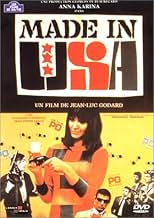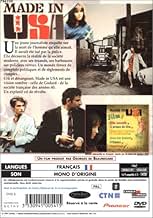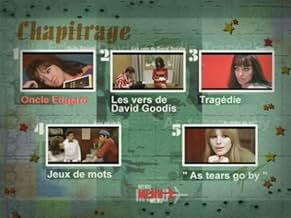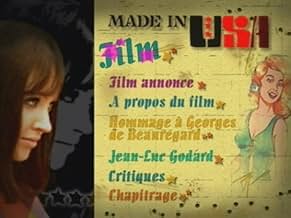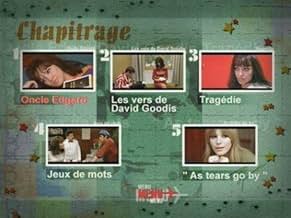Füge eine Handlung in deiner Sprache hinzuIn the near future, leftist writer Paula goes from Paris to the French town of Atlantic-Cité when she learns of the death of a former colleague and lover, Richard P. Is she there to investig... Alles lesenIn the near future, leftist writer Paula goes from Paris to the French town of Atlantic-Cité when she learns of the death of a former colleague and lover, Richard P. Is she there to investigate? On the surface, faces are beautiful, colors bright, clothes trendy. Beneath, little i... Alles lesenIn the near future, leftist writer Paula goes from Paris to the French town of Atlantic-Cité when she learns of the death of a former colleague and lover, Richard P. Is she there to investigate? On the surface, faces are beautiful, colors bright, clothes trendy. Beneath, little is clear: some talk to Paula as if she's Alice in Wonderland, corpses pile up, and ideologi... Alles lesen
- Regie
- Drehbuch
- Hauptbesetzung
- Paula Nelson
- (as AK)
- Richard Widmark
- (as LS)
- Donald Siegel
- (as JPL)
- David Goodis
- (as YA)
- Man with Marianne Faithfull
- (Nicht genannt)
- Policeman
- (Nicht genannt)
- Richard Nixon
- (Nicht genannt)
- Inspector Aldrich
- (Nicht genannt)
- Bill Poster
- (Nicht genannt)
- Barman
- (Nicht genannt)
- Workman in bar
- (Nicht genannt)
- Dental Assistant
- (Nicht genannt)
- Richard Politzer
- (Synchronisation)
- (Nicht genannt)
- Robert MacNamara
- (Nicht genannt)
- Girl in Bandages
- (Nicht genannt)
- Doris Mizoguchi
- (Nicht genannt)
- Self
- (Nicht genannt)
Empfohlene Bewertungen
Out of 100, I give it 71. That's good for ** out of ****.
Seen at home, in Toronto, on November 26th, 2002.
The often curious soundtrack features a passing jet aircraft (or is it an express train?) which always obscures the surname of Karina's mysterious, deceased lover in a fashion that Tarrentino late used to obscure the name of the'The Bride' in KILL BILL.
What's it all about? No idea! But the film, or maybe the style, certainly the luminous Karina, does somehow get under your skin and even though I found it hard to endure on a first viewing I'm increasingly keen to watch it once again . Amongst the mind-boggling strangeness I'm sure I must have missed something vital....now, where is that DVD?
Neon signs and electronic news ribbons proliferate. So do comic strips and film stills. Most of the characters, like Donald Siegel and Doris Mizoguchi, are named for Godard's favorite movie figures, and allusions to American movie characters are everywhere, including three from three separate films by Otto Preminger, who also has a street named for him in the movie's make-believe Atlantic City. This stunningly self-conscious political diatribe's cinephilic gags and cartoon violence smack of Alphaville.
In her final performance for Godard, Anna Karina is Paula Nelson, a P.I. swathed in an overcoat and packing heat. As The Big Sleep has an infamously indecipherable plot, one of whose many murders not even Hawks could clarify, so this is Godard's most unrelentingly unbalanced of plot convention. Crucial scenes, if you can call them that, are systematically minced right at the moment of revelation. Information in the dialogue is resolutely buried by street noise or two brash Beethoven chords, as, variantly seductive and apathetic, Paula goes looking for an ostensibly vanished lover, likely dead, in a tangled, tortuous, never elucidated international political conspiracy.
Supposedly, Godard had much more than Raymond Chandler and Donald E. Westlake on one's mind. This patchwork mingles the Americanization of French life with the widespread controversy of mid-60s France, the vanishing of Morocco's foremost leftist, a political expatriate in France and a third-world personage then akin to Malcolm X or Che Guevara, kidnapped by French police acting in cahoots with the Moroccan government, which evidently had him tortured to death on French terrain. That he disappeared while traveling to a development meeting for a documentary, made the incident even more dramatic for Godard. Supposedly, this work of sociopolitical meta fiction is an imagining that he'd not died but had hidden in the provinces, wrote to his girlfriend to meet him. When she gets there, she discovers him dead.
So the movie starts with Paula secluded in a shoddy hotel room in the characterless Paris suburb that doubles for Atlantic City, reflecting on her state of affairs while a couple of hooligans, played by New Wave regulars László Szabó and Jean-Pierre Léaud, linger portentously under her window. "Hanging out" is one of the movie's "active" (if that word could be used) factors. This awkward satire has characteristics of the sometimes fascinating, sometimes pedantic time-languishing revue that distinguished the art-house of the '60s. Early on, Marianne Faithful sits inexplicably in a neighborhood café, nonchalantly trilling As Tears Go By a cappella. But chiefly, Raoul Coutard's camera stares at the star, a statue. Frankly, you could forget all about the political and sociological vinegar and find the movie's really all about contemplating Karina's concealed grins, her dark hair, her switching clothes, and her eerie ability to turn any given shot into a fashion promo. Considering that we hear her voice-over all over, it's not unlike a Jarmusch-esque lone wolf enterprise.
Plot, to use the term carelessly, accelerates when Paula slays the irritating midget stoolie Mr. Typhus: "Now fiction overtakes reality," she self-narrates. Storytelling is leaps and bounds more complicated and theoretically brutal here as in The Big Sleep or Kiss Me Deadly. Like Marlowe or Hammer, Paula finds a succession of corpses during her mission. She also leaves a footpath of others as her own upshot, including one whom she just shoots at close range. Later on, she serves the movie's most celebrated, and loaded, line: "We were in a political movie. Walt Disney with blood." Roughly when characters named Nixon and McNamara show up as hoodlums, played by young film critics, the reel-to-reel tape recorders that have been sporadically stationary in close-up to play messages left by Paula's lover change to egalitarian discourse.
The movie is anti-capitalist and anti-consumerist, condemning miniskirts and rock and roll as manner of fascist brainwashing, but more invested in the kitschy modernism favored by the informal consensus within the mainstream of Western culture than any movie Godard made prior or since. Paula asserts that advertising is a form of fascism, representing the director. It's a legitimate grievance and an upsetting one, considering that Made in U.S.A. is a relentless commercial for itself. Perhaps the cleverest thing about it might be its title, which offers perspective on that element.
Pending this work, Godard was a nationalist for some, a populist for others, but didn't folks assert the same thing about Orson Welles? And yet for others, he was just an armchair politico. Made in U.S.A. is an opinionated exploit that's equally as sincere as a formal expression of political will, a judgmental breakdown of pop culture and a cautionary lecture in which, this time, the filmmaker has become so explicitly caught up that he felt he had to film it himself.
It seems the real inspiration behind this was the disappearance of a prominent Moroccan leftist leader in Paris, Ben Barka. One can imagine the scandal caused at the time, how much it said about France and the West, especially to someone like Godard who would be attuned to receive it.
The first thing to glean then is that instead of filming the outrage, the obscuring of truth and malaise, using fiction, Godard reverts back to image and cinema, about fiction. To that effect he plucks a potboiler story from a book about a woman who travels to a coastal town where her revolutionary lover has told her to meet him only to find him mysteriously dead, but instead of filming the mystery and noir conspiracy, Godard films a disjointed tapestry of image and citation.
There are many of these, quotes, abrupt cuts and insertions, ruminations on camera, agitprop played from tape-recorders, all first of course Godard's fooling with cinema to see what it is made of, but moreover his oblique way of delivering the obscuring of truth, the disjointed nature of living in a world where people can mysteriously disappear and we can only grasp at fictions. As more of an afterthought he can joke that this knot of indecipherable plot is his version of The Big Sleep.
More fascinating is what all this shows of Godard. There's a bourgeois intellectual in him, that side of him he would run away from after Weekend, who wants to present his view of a concave reality, but none of it deep, transformative or unsettling, always thinly exposing thin artifice. There's of course talk of Disney and Bogart, there's a Rue Preminger, an inspector Aldrich. Tarantino- isms.
But also a spiritual side of him, a burning desire to transcend the clutter of narratives and mind; at one point Anna Karina whispers about how she would rather have nothing instead of everything as a way of reaching the absolute, it's this absolute that likely he chased in the chimera of politics and beyond. He doesn't know yet that this nothingness is not only another thought or another belief but a cessation of thought, a suspension of disbelief. He would later.
It's this other Godard who is a gentle soul, contains the child fascinated by image, the poet fascinated by love, perhaps not the philosopher troubled by being which was only more thought stood in his way. This side is as stifled here, unable to pierce through the cutouts, as it was after Weekend when he wasted his talent in things like Pravda, and was only really let flourish in the 90s, his transcendent period when you must find him again.
Paula (Anna Karina), a journalist, goes to a small town where her estranged boyfriend Richard has died in mysterious circumstances, surely murder. Determined to get to the bottom of things, she takes on the air of a hardboiled detective, wielding a pistol and wearing a Bogartian trenchcoat. She meets the doctor who did the autopsy and has a run-in with the police, but mainly we see her tangled up with two gangsters, played by László Szabó and Jean-Pierre Léaud.
Godard maintains just enough conventional dialogue and action to let the viewer know where we are in the crime novel's plot, but most of what transpires before the camera must be understood as only abstract metaphors for what would have happened in the book. The interaction between his characters mainly has other purposes. They have absurdist conversations with a great deal of wordplay. They allude to French politics in a time when Godard was worried about the compromised values of the French Left and the spectres of fascism and consumer society. The Ben Barka affair, where a Moroccan dissident was murdered in France in 1965 with the apparent involvement of the French security services, looms very large over MADE IN U.S.A., almost elbowing Westlake's original story out entirely. As if aware that he had stripped the plot down to such a degree that he now had too much time to be filled, he gives little asides like Marianne Faithful singing "Tears Go By" a cappella in a cameo and Kyôko Kosaka strumming a guitar and singing in Japanese.
This is not one of Godard's best films. For one, Godard reused many of the elements of his masterpiece PIERROT LE FOU from the year before. PIERROT LE FOU was itself assembled as sort of a collage of shots from Godard's prior films, which worked well as a wonderful summing up of his early career. But when he does the same with MADE IN U.S.A., it is to greatly diminished effect. But even if this is weak by Godard standards, it is nonetheless a moving experience. Shot in colour and in Cinemascope, this is a feast for the eyes. The very best of what the 1960s had to offer in terms of fashion and product design is on hand here and it just jumps of the screen. The image feels electric. (It is a pity that Criterion's edition is only on DVD, as a Blu-Ray would have yielded even greater pleasures.) Godard's longtime cameraman Raoul Coutard gives us some elaborate long takes that impress. And of course it's Godard's last major celebration of Anna Karina's beauty and poise, which really was something for the ages, still stunning half a century later.
Wusstest du schon
- WissenswertesThough based on "The Jugger" by Richard Stark (Donald E. Westlake), the author received no compensation for this adaptation. Westlake, who passed away at the end of 2008, successfully kept the film from being shown in the US during his lifetime.
- Zitate
Marianne Faithfull: It is the evening of the day / I sit and watch the children play / Smiling faces I can see / But not for me / I sit and watch / As tears go by / My riches can't buy everything / I want to hear the children sing / All I hear is the sound / Of rain falling on the ground / I sit and watch / As tears go by / It is the evening of the day / I sit and watch the children play / Doing things I used to do / They think are new / I sit and watch / As tears go by
- VerbindungenEdited into Bande-annonce de 'Made in U.S.A.' (1966)
- SoundtracksAs Tears Go By
Written by Mick Jagger, Keith Richards and Andrew Loog Oldham
Performed by Marianne Faithfull
Top-Auswahl
- How long is Made in U.S.A?Powered by Alexa
Details
Box Office
- Budget
- 50.000 $ (geschätzt)
- Bruttoertrag in den USA und Kanada
- 95.209 $
- Eröffnungswochenende in den USA und in Kanada
- 11.147 $
- 11. Jan. 2009
- Weltweiter Bruttoertrag
- 95.304 $
- Laufzeit1 Stunde 30 Minuten
- Sound-Mix
- Seitenverhältnis
- 2.35 : 1
Zu dieser Seite beitragen





